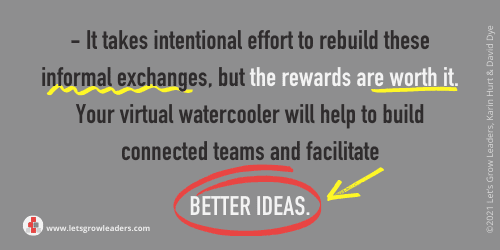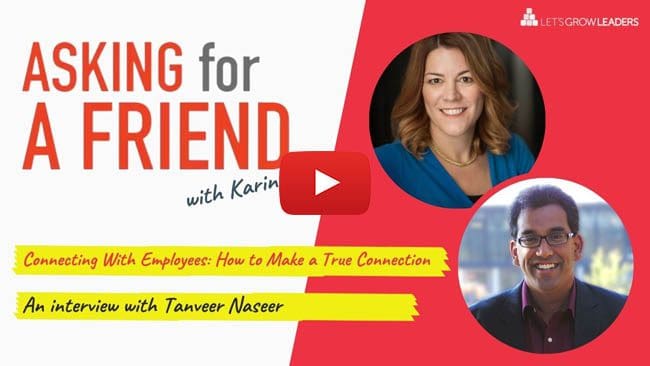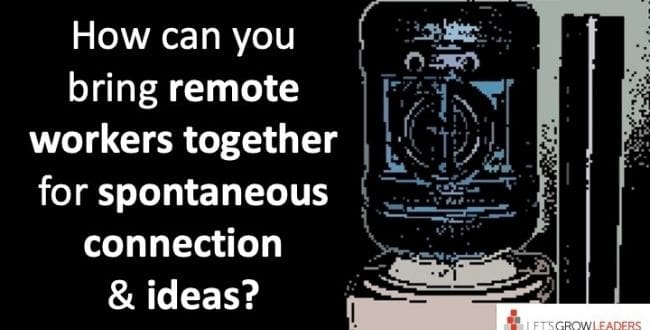Help Your Team Stay Connected While Working on Virtual Teams
One of the most frequent concerns we hear from leaders and teams (where remote work is the foreseeable norm) is the lack of a virtual watercooler. That metaphorical place where people exchange ideas, build connections, and spontaneous innovation thrives.
 The informal exchange of ideas is critical for innovation and building relationships.
The informal exchange of ideas is critical for innovation and building relationships.
Fortunately, you can create spaces and interactions that simulate or improve upon the accidental connections that happen when you’re in the same building.
But it does require different ways of thinking and interacting.
As you’re thinking about how to re-create these interactions, it may be helpful to reflect on why watercoolers have become shorthand for these dynamics. The prosaic watercooler wasn’t designed as a place for team members to build relationships and share ideas.
But it works. Well.
Why? One reason is that it feels easy … no pressure … just chatting.
It’s the same reason people tell us the best conversations that happen at conferences happen during the coffee breaks.
So, how can you bring people together to cultivate spontaneous connections and new ideas?
3 Ways to Create that Virtual Watercooler
1. Create a standing “watercooler room”
One of the most straightforward ways to re-create that gathering space is to build an online version. A Zoom or Teams video meeting that stays open, where people can drop in to say hi, take breaks, and talk about whatever they want.
To get people used to its availability, it may help to have a natural reason people would want to stop by. Perhaps a different daily resource, fun prompt, or shared activity or whiteboard.
Standing “break room” Slack or Teams channels can also play this role. We’ve seen organizations create dedicated spaces for work-related free-form discussions as well as personal topics like exchanging recipes, following sports, and many more.
2. Use quick parallel conversations
We’ve been inspired by teams around the world who come together quickly to solve problems, get creative, riff on ideas, and chart strategic action–in minutes, not days.
The secret to this rapid creativity and strategic problem-solving?
Breakout rooms.
There are so many ways to use the power of breakout rooms for fast parallel thinking.
You can seed the conversation with one meaningful, specific “How can we?” question and have each room address it – or give each room a different question or aspect of the challenge ahead. Or hold a quick standup meeting where people address one current challenge, then design a rapid-breakout session to address solutions for the three most common issues.
Create groups of 4-6 people, create a time limit that feels slightly too short, and get out of the way to let people engage with one another. The secret is to make these conversations relevant and fast. The best result is if one group says, “let’s keep talking” and then does.
3. Get personal with meaningful prompts
It is possible to build and nurture human relationships remotely. We know because we’ve done it with clients and friends around the world. Whether you’re starting a business meeting with human connection or facilitating a virtual social hour, how can you be intentional and increase everyone’s understanding of one another?
The key is to use meaningful prompts. You might introduce the process with easier topics like hobbies, but over time, move to more meaningful conversations.
 One of our favorites is “What are you most proud of?”–either in life, work, or any other aspect of life. This gives everyone quick insight into a person in a way that’s safe and not too vulnerable.
One of our favorites is “What are you most proud of?”–either in life, work, or any other aspect of life. This gives everyone quick insight into a person in a way that’s safe and not too vulnerable.
We’ve also worked with teams who have used questions like “What has been your source of strength or inspiration over the past months?” “Can you show us a picture or object associated with your source of strength and inspiration?”
More Ways to Build Deeper Connection in Your Virtual Teams
Karin Hurt talks with Tanveer Naseer about more ways to build trust and connection in remote teams on this special edition of Asking For a Friend.

It takes intentional effort to rebuild these informal exchanges, but the rewards are worth it. Your virtual watercooler will help to build connected teams and facilitate better ideas.
We’d love to hear from you. What are the most effective ways you’ve seen remote teams rebuild informal gatherings?
You might also like:
How to Get Better at Remote Small Talk
How to Find the Best Ideas to Make Remote Work Easier
Beyond the Basics: Online Meetings that Don’t Suck Your Soul







Our team has found it helpful to have a virtual coffee break every now and then. It’s a great opportunity to not only brainstorm about projects/challenges we are facing at work but to also provide a certain level of dialogue about what is going on in people’s lives outside of work.
Thanks John! Great suggestion
That physical place to exchange ideas and build connections with people is certainly missed for remote teams, but I love the creativity and original ideas that are coming up to replace that water cooler in a virtual world.
It’s helpful to have a general “break room” channel – we use this to share stories, interesting links, or other diversions. I’m trying to get the team into a “Strava” posting habit (pictures, activity, maps and mileage), each time we work out to encourage each other as we achieve personal fitness goals. Both can help us invest in one-another as people.
Shelley, I love the idea of a “break room” channel. We had one client who created various slack channels for different interests (e.g. healthy recipes, pets etc). People really seemed to resonate with that. Today I cycled 41 miles in preparation for my mountain race this Summer 😉
This sounds like a great start to sparking creativity within the virtual work environment. Your ideas got me thinking about what a great brainstorming activity it could be for a team to come up with ways to strengthen connection while remote. Posting photos of a workspace environment they are proud of, sending the team a quick 30-second short film to say hello, sharing personal goals/achievements, funny stories, etc. Lots of positives come to mind.